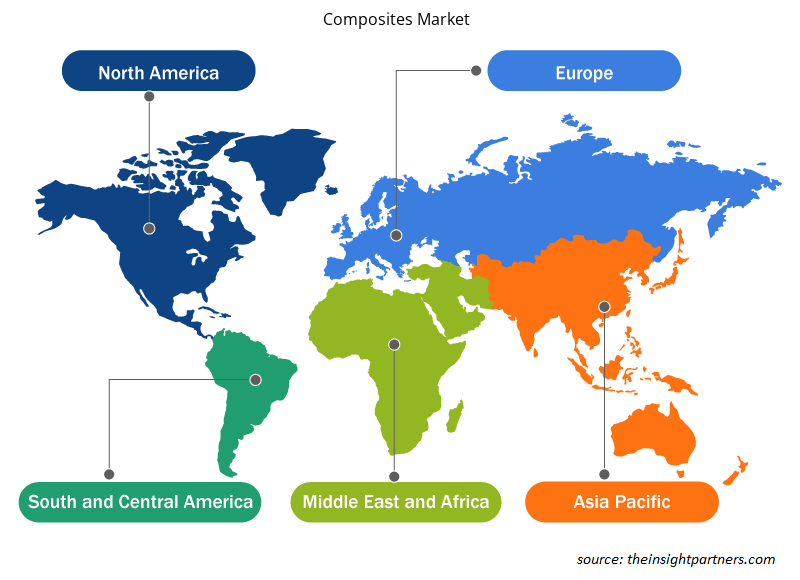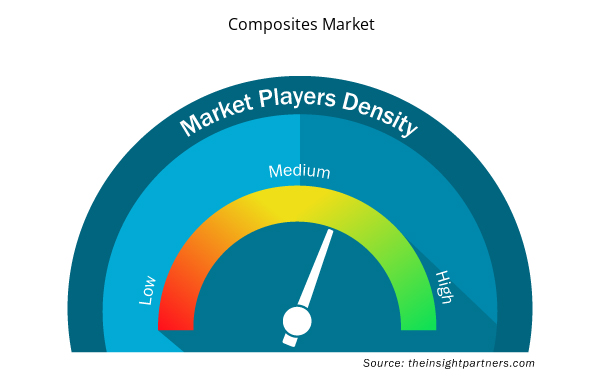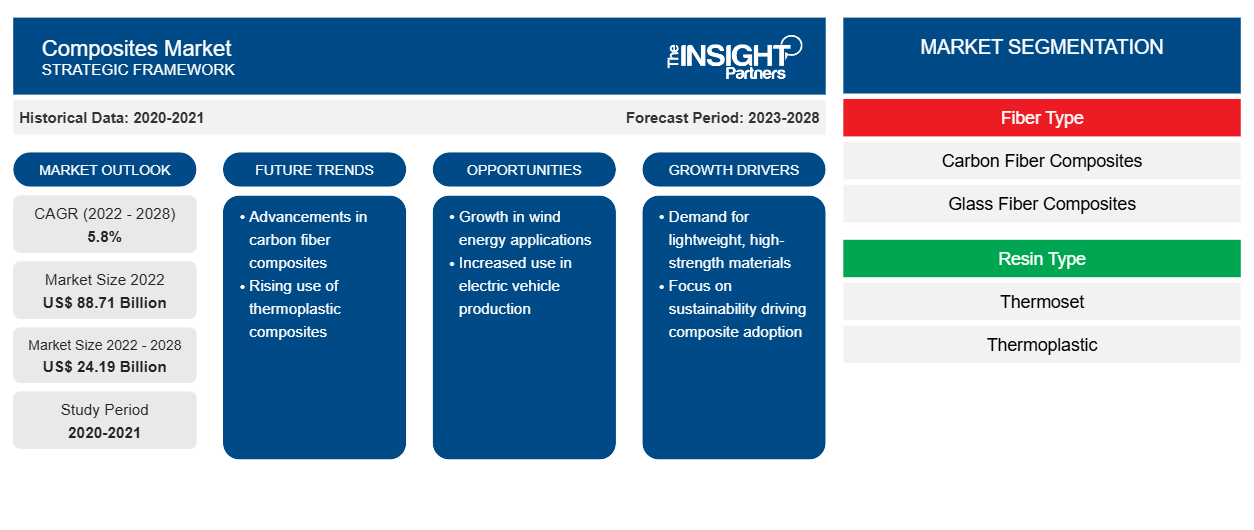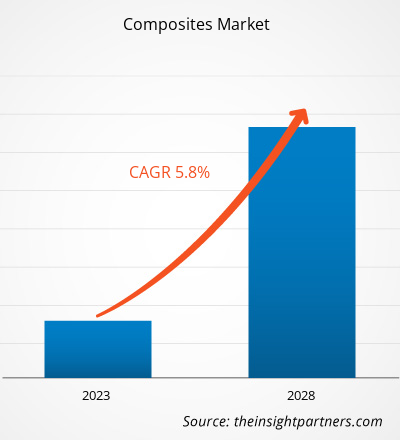Der Markt für Verbundwerkstoffe soll von 88.710,42 Millionen US-Dollar im Jahr 2022 auf 124.185,35 Millionen US-Dollar im Jahr 2028 wachsen; von 2022 bis 2028 wird mit einer durchschnittlichen jährlichen Wachstumsrate von 5,8 % gerechnet.
Verbundwerkstoffe sind im Vergleich zu den meisten Hölzern und Metallen leicht. Aufgrund ihres geringen Gewichts sind Verbundwerkstoffe in Autos und Flugzeugen gefragt, da sie weniger Treibstoff verbrauchen. Heutzutage legen Flugzeugkonstrukteure großen Wert auf das Gewicht, da eine Gewichtsreduzierung den Treibstoffbedarf eines Flugzeugs senkt und die erreichbare Geschwindigkeit erhöht. Darüber hinaus sind Verbundwerkstoffe widerstandsfähiger gegen Witterungseinflüsse und aggressive Chemikalien. Sie lassen sich leichter in komplizierte Formen bringen als die meisten anderen Materialien.
Im Jahr 2022 hatte der asiatisch-pazifische Raum den größten Umsatzanteil am globalen Verbundwerkstoffmarkt . Die Nachfrage nach Verbundwerkstoffen im asiatisch-pazifischen Raum steigt aufgrund der zunehmenden Verwendung von Verbundwerkstoffen in verschiedenen Endverbrauchsbranchen wie Automobil, Windenergie, Bauwesen, Sportartikeln und vielen anderen. Die wachsende Bauindustrie trägt stark zum Wachstum des Verbundwerkstoffmarktes in der Region bei. Der asiatisch-pazifische Raum erlebt eine Urbanisierung sowie den zunehmenden Bau von Wohn- und Gewerbeprojekten. Darüber hinaus ist das Pro-Kopf-Einkommen in der Region gestiegen, verbunden mit der Entwicklung erschwinglicher Wohngebäude. Dies hat zu einer raschen Urbanisierung im asiatisch-pazifischen Raum geführt. Die vorteilhafte Regierungspolitik im Zusammenhang mit der Entwicklung von Wohnimmobilien in mehreren Ländern der Region hat die Urbanisierung vorangetrieben. Darüber hinaus gehören Länder wie China und Indien zu den fünf Ländern der Welt mit der größten installierten Windkraft. All diese Faktoren tragen positiv zum Wachstum des Verbundwerkstoffmarktes in der Region bei.
Passen Sie diesen Bericht Ihren Anforderungen an
Sie erhalten kostenlos individuelle Anpassungen an jedem Bericht, einschließlich Teilen dieses Berichts oder einer Analyse auf Länderebene, eines Excel-Datenpakets sowie tolle Angebote und Rabatte für Start-ups und Universitäten.
- Holen Sie sich die wichtigsten Markttrends aus diesem Bericht.Dieses KOSTENLOSE Beispiel umfasst eine Datenanalyse von Markttrends bis hin zu Schätzungen und Prognosen.
Auswirkungen der COVID-19-Pandemie auf den Verbundwerkstoffmarkt
Branchen wie die Automobil-, Luft- und Raumfahrt-, Bau-, Schifffahrts- und Energiebranche haben am meisten zur Nachfrage nach Verbundwerkstoffen beigetragen. Im Jahr 2020 mussten diese Branchen ihre Betriebsabläufe aufgrund von Störungen in der Wertschöpfungskette aufgrund der Schließung nationaler und internationaler Grenzen verlangsamen. Der Mangel an Arbeitskräften führte zu einer Verlangsamung der Produktion und des Vertriebs von Verbundwerkstoffen. Störungen in der globalen Lieferkette und die Schließung von Harzproduktionsanlagen führten zu einem starken Anstieg der Preise für Verbundwerkstoffe. Die von verschiedenen Ländern im Jahr 2020 verhängten Lockdowns behinderten die Fähigkeit der Branchen, ihre Lagerbestände aufrechtzuerhalten. Darüber hinaus reduzierten Hygienemaßnahmen und andere COVID-19-Vorsichtsmaßnahmen die Produktionskapazität erheblich, was zu einem Mangel an Verbundwerkstoffbeständen führte. Im Jahr 2021 begann sich der Weltmarkt jedoch von den im Jahr 2020 erlittenen Verlusten zu erholen, als die Regierungen verschiedener Länder Lockerungen der sozialen Beschränkungen ankündigten. Darüber hinaus trugen steigende Impfraten zu einer Verbesserung der Gesamtbedingungen in verschiedenen Ländern bei, was zu einem förderlichen Umfeld für industriellen und kommerziellen Fortschritt führte. Laut dem Weltwirtschaftsforum hat die COVID-19-Pandemie das Potenzial, Innovationen im Hausdesign hervorzubringen und dürfte neue Möglichkeiten im Bereich der Hausrenovierung bieten. Dieser Faktor dürfte im Prognosezeitraum lukrative Möglichkeiten für das Wachstum des Verbundwerkstoffmarktes bieten.
Markteinblicke
Steigende Nachfrage nach Leichtbaumaterialien in der Automobil- und Luftfahrtindustrie
Automobilhersteller bevorzugen leichte Materialien für die Herstellung von Autos und gewährleisten gleichzeitig Sicherheit und Leistung. Leichte Materialien haben ein hervorragendes Potenzial zur Verbesserung der Kraftstoffeffizienz. Eine 10-prozentige Verringerung des Fahrzeuggewichts kann zu einer Verbesserung der Kraftstoffeffizienz um 6–8 % führen. Moderne Materialien wie Kohlenstofffaserverbundstoffe haben das Potenzial, das Gewicht von Automobilkomponenten um 50–75 % zu reduzieren. Die Anwendung von Verbundstoffen im Automobilsektor nimmt weiter zu. Kunststoffverbundstoffe haben im Vergleich zu Verbundstoffen nicht erneuerbarer Herkunft hervorragende akustische und thermische Eigenschaften, was sie ideal für Fahrzeuginnenteile macht. Darüber hinaus eignen sie sich für die Herstellung nicht struktureller Innenraumkomponenten, einschließlich Sitzpolstern, Sitzlehnen, Dachhimmeln, Innenverkleidungen und Armaturenbrettern. Darüber hinaus bemühen sich Flugzeughersteller, die primären thermoplastischen Strukturen in Geschäfts- und Verkehrsflugzeugen zu vergrößern. Sie waren die ersten Anwender langfaserverstärkter Thermoplaste.
Einblicke in den Fasertyp
Basierend auf dem Fasertyp ist der globale Markt für Verbundwerkstoffe in Kohlefaserverbundwerkstoffe, Glasfaserverbundwerkstoffe und andere unterteilt. Der globale Marktanteil des Segments Glasfaserverbundwerkstoffe war im Jahr 2022 der größte. Glasfaserverbundwerkstoffe werden mit verschiedenen Fertigungstechnologien hergestellt und für eine breite Palette von Anwendungen eingesetzt. Glasfasern weisen mehrere Eigenschaften auf, nämlich hohe Festigkeit, Flexibilität, Haltbarkeit und Beständigkeit gegen chemische Schäden. Sie können in Form von Rovings, geschnittenen Strängen, Garnen, Geweben und Matten vorliegen. Jeder Glasfasertyp hat unterschiedliche Eigenschaften und wird in Form von Polymerverbundwerkstoffen für verschiedene Anwendungen verwendet. Glasfaserverbundwerkstoffe werden aufgrund ihrer günstigen Eigenschaften wie hohem Festigkeits-Gewichts-Verhältnis, guter Dimensionsstabilität, guter Hitze- und Korrosionsbeständigkeit, guten elektrischen Isoliereigenschaften, einfacher Herstellung und relativ niedrigen Kosten für industrielle Anwendungen sehr bevorzugt.
Zu den wichtigsten Akteuren auf dem globalen Verbundwerkstoffmarkt zählen DuPont de Nemours Inc, Gurit Holding AG, Hexion Inc, Mitsubishi Chemical Holdings Corp, Nippon Electric Glass Co Ltd, Owens Corning, SGL Carbon SE, Teijin Ltd, Solvay SA und Toray Industries Inc. Die Akteure auf dem globalen Verbundwerkstoffmarkt konzentrieren sich auf die Bereitstellung hochwertiger Produkte, um die Kundennachfrage zu erfüllen. Sie konzentrieren sich auch auf Strategien wie Investitionen in Forschungs- und Entwicklungsaktivitäten und die Einführung neuer Produkte.
Bericht-Spotlights
- Fortschrittliche Branchentrends auf dem Verbundwerkstoffmarkt helfen den Akteuren bei der Entwicklung wirksamer langfristiger Strategien
- In Industrie- und Entwicklungsländern angewandte Strategien für Unternehmenswachstum
- Quantitative Analyse des Verbundwerkstoffmarktes von 2020 bis 2028
- Schätzung der weltweiten Nachfrage nach Verbundwerkstoffen
- Porters Fünf-Kräfte-Analyse zur Veranschaulichung der Wirksamkeit der in der Branche tätigen Käufer und Lieferanten
- Aktuelle Entwicklungen zum Verständnis des wettbewerbsorientierten Marktszenarios
- Markttrends und -aussichten sowie Faktoren, die das Wachstum des Verbundwerkstoffmarktes vorantreiben und bremsen
- Unterstützung im Entscheidungsprozess durch Aufzeigen von Marktstrategien, die das kommerzielle Interesse untermauern und zum Marktwachstum führen
- Die Größe des Verbundwerkstoffmarktes an verschiedenen Knotenpunkten
- Detaillierte Übersicht und Segmentierung des Marktes sowie der Dynamik der Verbundwerkstoffindustrie
- Die Größe des Verbundwerkstoffmarktes in verschiedenen Regionen mit vielversprechenden Wachstumschancen
Regionale Einblicke in den Verbundwerkstoffmarkt
Die regionalen Trends und Faktoren, die den Verbundwerkstoffmarkt im Prognosezeitraum beeinflussen, wurden von den Analysten von Insight Partners ausführlich erläutert. In diesem Abschnitt werden auch die Marktsegmente und die Geografie des Verbundwerkstoffmarkts in Nordamerika, Europa, im asiatisch-pazifischen Raum, im Nahen Osten und Afrika sowie in Süd- und Mittelamerika erörtert.

- Erhalten Sie regionale Daten zum Verbundwerkstoffmarkt
Umfang des Marktberichts zu Verbundwerkstoffen
| Berichtsattribut | Details |
|---|---|
| Marktgröße im Jahr 2022 | 88,71 Milliarden US-Dollar |
| Marktgröße bis 2028 | 24,19 Milliarden US-Dollar |
| Globale CAGR (2022 - 2028) | 5,8 % |
| Historische Daten | 2020-2021 |
| Prognosezeitraum | 2023–2028 |
| Abgedeckte Segmente | Nach Fasertyp
|
| Abgedeckte Regionen und Länder | Nordamerika
|
| Marktführer und wichtige Unternehmensprofile |
|
Dichte der Marktteilnehmer im Verbundwerkstoffbereich: Auswirkungen auf die Geschäftsdynamik verstehen
Der Markt für Verbundwerkstoffe wächst rasant. Die steigende Nachfrage der Endverbraucher ist auf Faktoren wie sich entwickelnde Verbraucherpräferenzen, technologische Fortschritte und ein größeres Bewusstsein für die Vorteile des Produkts zurückzuführen. Mit der steigenden Nachfrage erweitern Unternehmen ihr Angebot, entwickeln Innovationen, um die Bedürfnisse der Verbraucher zu erfüllen, und nutzen neue Trends, was das Marktwachstum weiter ankurbelt.
Die Marktteilnehmerdichte bezieht sich auf die Verteilung der Firmen oder Unternehmen, die in einem bestimmten Markt oder einer bestimmten Branche tätig sind. Sie gibt an, wie viele Wettbewerber (Marktteilnehmer) in einem bestimmten Marktraum im Verhältnis zu seiner Größe oder seinem gesamten Marktwert präsent sind.
Die wichtigsten auf dem Verbundwerkstoffmarkt tätigen Unternehmen sind:
- DuPont de Nemours Inc
- Gurit Holding AG
- Hexion Inc
- Mitsubishi Chemical Holdings Corp
- Nippon Electric Glass Co Ltd
Haftungsausschluss : Die oben aufgeführten Unternehmen sind nicht in einer bestimmten Reihenfolge aufgeführt.

- Überblick über die wichtigsten Akteure auf dem Verbundwerkstoffmarkt
Globaler Verbundwerkstoffmarkt
Basierend auf dem Fasertyp ist der globale Verbundwerkstoffmarkt in Kohlefaserverbundwerkstoffe, Glasfaserverbundwerkstoffe und andere unterteilt. Basierend auf dem Harztyp ist der globale Verbundwerkstoffmarkt in Duroplaste und Thermoplaste unterteilt. Das Duroplastsegment ist weiter unterteilt in Polyester, Vinylester, Epoxid, Polyurethan und andere. Das Thermoplastsegment ist weiter unterteilt in Polypropylen, Polyethylen, Polyvinylchlorid, Polystyrol, Polyethylenterephthalat, Polycarbonat und andere. Basierend auf der Endverbrauchsbranche ist der globale Verbundwerkstoffmarkt in Automobil, Luft- und Raumfahrt und Verteidigung, Wind, Bauwesen, Marine, Sportartikel und andere unterteilt.
Firmenprofile
- DuPont de Nemours Inc
- Gurit Holding AG
- Hexion Inc
- Mitsubishi Chemical Holdings Corp
- Nippon Electric Glass Co Ltd
- Owens Corning
- SGL Carbon SE
- Teijin GmbH
- Solvay SA
- Toray Industries Inc.
- Historische Analyse (2 Jahre), Basisjahr, Prognose (7 Jahre) mit CAGR
- PEST- und SWOT-Analyse
- Marktgröße Wert/Volumen – Global, Regional, Land
- Branche und Wettbewerbsumfeld
- Excel-Datensatz



Report Coverage
Revenue forecast, Company Analysis, Industry landscape, Growth factors, and Trends

Segment Covered
This text is related
to segments covered.

Regional Scope
North America, Europe, Asia Pacific, Middle East & Africa, South & Central America

Country Scope
This text is related
to country scope.
Häufig gestellte Fragen
The increasing demand for lightweight materials from automotive & aerospace industry, and rising utilization of glass-fiber composites in end-use industries, are some of the key driving factors for the composites market.
Based on end-use industry, wind energy is the fastest-growing segment. The rising adoption of composites in renewable energy due to properties such as lightweight, and lower maintenance costs, is driving the segment’s growth. At present, research and development is highly focused towards innovative materials aimed to satisfy turbine requirements such as increased size turbine and rotor blades for land-based and off-shore systems.
The applications of composites in wind energy sector, is expected to provide lucrative growth opportunities to the global composites market during the forecast period.
Asia Pacific composites market is driven by growth in end-use industries such as wind power, electronics, and automotive industries, which is expected to create favorable business opportunities for the composites market during the forecast period. Therefore, Asia Pacific accounts for the largest share of the global composites market.
The major players operating in the global composites market are Mitsubishi Chemical Holdings Corp; Nippon Electric Glass Co Ltd; Solvay SA; Toray Industries Inc; DuPont de Nemours Inc; amongst others.
Glass fiber composite materials are highly preferred for industrial applications due to their favorable characteristics such as high strength-to-weight ratio, good dimensional stability, good resistance to heat and corrosion, good electrical insulation properties, ease of fabrication, and relatively low cost. Therefore, this factor is expected to boost the glass fiber composites segment’s share.
Trends and growth analysis reports related to Chemicals and Materials : READ MORE..
The List of Companies - Composites Market
- DuPont de Nemours Inc
- Gurit Holding AG
- Hexion Inc
- Mitsubishi Chemical Holdings Corp
- Nippon Electric Glass Co Ltd
- Owens Corning
- SGL Carbon SE
- Teijin Ltd
- Solvay SA
- Toray Industries Inc
The Insight Partners performs research in 4 major stages: Data Collection & Secondary Research, Primary Research, Data Analysis and Data Triangulation & Final Review.
- Data Collection and Secondary Research:
As a market research and consulting firm operating from a decade, we have published and advised several client across the globe. First step for any study will start with an assessment of currently available data and insights from existing reports. Further, historical and current market information is collected from Investor Presentations, Annual Reports, SEC Filings, etc., and other information related to company’s performance and market positioning are gathered from Paid Databases (Factiva, Hoovers, and Reuters) and various other publications available in public domain.
Several associations trade associates, technical forums, institutes, societies and organization are accessed to gain technical as well as market related insights through their publications such as research papers, blogs and press releases related to the studies are referred to get cues about the market. Further, white papers, journals, magazines, and other news articles published in last 3 years are scrutinized and analyzed to understand the current market trends.
- Primary Research:
The primarily interview analysis comprise of data obtained from industry participants interview and answers to survey questions gathered by in-house primary team.
For primary research, interviews are conducted with industry experts/CEOs/Marketing Managers/VPs/Subject Matter Experts from both demand and supply side to get a 360-degree view of the market. The primary team conducts several interviews based on the complexity of the markets to understand the various market trends and dynamics which makes research more credible and precise.
A typical research interview fulfils the following functions:
- Provides first-hand information on the market size, market trends, growth trends, competitive landscape, and outlook
- Validates and strengthens in-house secondary research findings
- Develops the analysis team’s expertise and market understanding
Primary research involves email interactions and telephone interviews for each market, category, segment, and sub-segment across geographies. The participants who typically take part in such a process include, but are not limited to:
- Industry participants: VPs, business development managers, market intelligence managers and national sales managers
- Outside experts: Valuation experts, research analysts and key opinion leaders specializing in the electronics and semiconductor industry.
Below is the breakup of our primary respondents by company, designation, and region:

Once we receive the confirmation from primary research sources or primary respondents, we finalize the base year market estimation and forecast the data as per the macroeconomic and microeconomic factors assessed during data collection.
- Data Analysis:
Once data is validated through both secondary as well as primary respondents, we finalize the market estimations by hypothesis formulation and factor analysis at regional and country level.
- Macro-Economic Factor Analysis:
We analyse macroeconomic indicators such the gross domestic product (GDP), increase in the demand for goods and services across industries, technological advancement, regional economic growth, governmental policies, the influence of COVID-19, PEST analysis, and other aspects. This analysis aids in setting benchmarks for various nations/regions and approximating market splits. Additionally, the general trend of the aforementioned components aid in determining the market's development possibilities.
- Country Level Data:
Various factors that are especially aligned to the country are taken into account to determine the market size for a certain area and country, including the presence of vendors, such as headquarters and offices, the country's GDP, demand patterns, and industry growth. To comprehend the market dynamics for the nation, a number of growth variables, inhibitors, application areas, and current market trends are researched. The aforementioned elements aid in determining the country's overall market's growth potential.
- Company Profile:
The “Table of Contents” is formulated by listing and analyzing more than 25 - 30 companies operating in the market ecosystem across geographies. However, we profile only 10 companies as a standard practice in our syndicate reports. These 10 companies comprise leading, emerging, and regional players. Nonetheless, our analysis is not restricted to the 10 listed companies, we also analyze other companies present in the market to develop a holistic view and understand the prevailing trends. The “Company Profiles” section in the report covers key facts, business description, products & services, financial information, SWOT analysis, and key developments. The financial information presented is extracted from the annual reports and official documents of the publicly listed companies. Upon collecting the information for the sections of respective companies, we verify them via various primary sources and then compile the data in respective company profiles. The company level information helps us in deriving the base number as well as in forecasting the market size.
- Developing Base Number:
Aggregation of sales statistics (2020-2022) and macro-economic factor, and other secondary and primary research insights are utilized to arrive at base number and related market shares for 2022. The data gaps are identified in this step and relevant market data is analyzed, collected from paid primary interviews or databases. On finalizing the base year market size, forecasts are developed on the basis of macro-economic, industry and market growth factors and company level analysis.
- Data Triangulation and Final Review:
The market findings and base year market size calculations are validated from supply as well as demand side. Demand side validations are based on macro-economic factor analysis and benchmarks for respective regions and countries. In case of supply side validations, revenues of major companies are estimated (in case not available) based on industry benchmark, approximate number of employees, product portfolio, and primary interviews revenues are gathered. Further revenue from target product/service segment is assessed to avoid overshooting of market statistics. In case of heavy deviations between supply and demand side values, all thes steps are repeated to achieve synchronization.
We follow an iterative model, wherein we share our research findings with Subject Matter Experts (SME’s) and Key Opinion Leaders (KOLs) until consensus view of the market is not formulated – this model negates any drastic deviation in the opinions of experts. Only validated and universally acceptable research findings are quoted in our reports.
We have important check points that we use to validate our research findings – which we call – data triangulation, where we validate the information, we generate from secondary sources with primary interviews and then we re-validate with our internal data bases and Subject matter experts. This comprehensive model enables us to deliver high quality, reliable data in shortest possible time.


 Holen Sie sich ein kostenloses Muster für diesen Bericht
Holen Sie sich ein kostenloses Muster für diesen Bericht